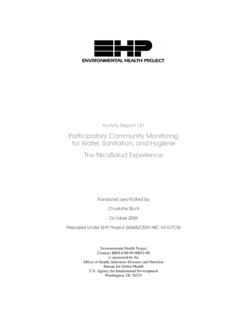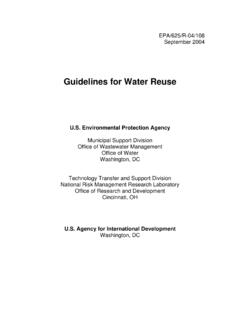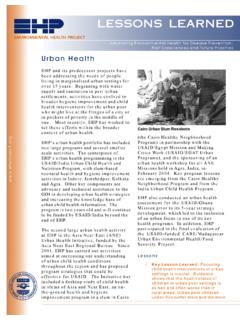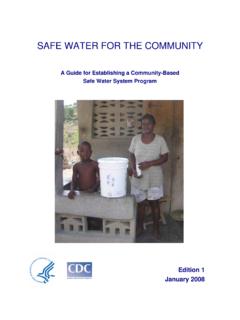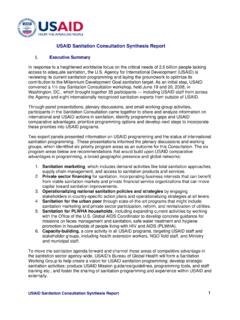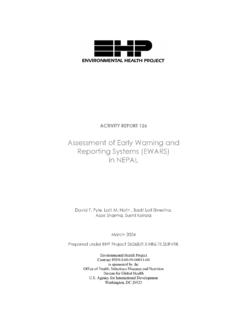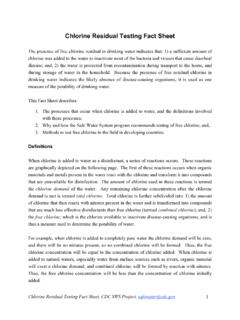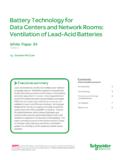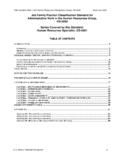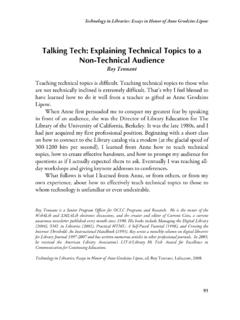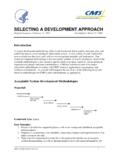Transcription of Selecting an Appropriate Technology for Human …
1 Selecting an Appropriate Technology for Human excreta Disposal Description of tool: This tool provides information that could help schools seeking to build or upgradesanitation facilities to choose suitable and sustainable technologies. A number ofexcreta disposal technologies are described, with particular emphasis on theoperations and maintenance requirements of each, as experience has shown this tobe a key factor in determining long-term project success. The information in this tool was adapted by UNESCO from the following publication: Brikk F. and Bredero M.
2 , 2003. Linking Technology Choice with Operation andMaintenance in the Context of Community Water Supply and Sanitation: AReference Document for Planners and Project Staff. Geneva: World HealthOrganization and IRC Water and Sanitation Centre. Description of document: This document aims to help decision-makers identify the most Appropriate technologyfor their water-supply and sanitation improvement projects, taking into account theconditions in the project area. The document focuses on developing countries, andprovides essential information on the types of water-supply and sanitationtechnologies available, including descriptions of the operation and maintenancerequirements of the technologies, the actors involved and the skills they must have oracquire.
3 It also addresses potential problems, including those that have been identifiedin prior water-supply and sanitation projects. Two basic principles outlined in thisdocument are that communities need to be involved in Selecting technologies from thestart of the process, and that planners should adopt a demand-driven approach. This information or activity supports CoreComponent #2 of the FRESH frameworkfor effective school health: water,sanitation & the environment. It willhave a greater impact if it is reinforced byactivities in the other three components ofthe framework. FRESH Tools for Effective School Health First Edition FRESH Tools for Effective School Health First Edition Selecting an Appropriate Technology for Human excreta Disposal1 1.
4 Introduction The provision of safe water and Appropriate sanitation facilities at school is one of the four components of the FRESH framework for comprehensive school health programming because of the tremendous positive impact that such measures have both for the health and education of school-age children. Clean water for drinking, washing and food preparation and safe Human excreta disposal are crucial for preventing the spread of infections that cause illness, disability and death among millions of children each year. Health status, and as the result, school enrolment, attendance, retention and learning can all be expected to improve when children have access to Appropriate water and sanitation facilities.
5 School authorities must ensure that on school grounds, at least, this is the case. Where such facilities are lacking or in poor repair, schools may need the support of government and/or private financing and expertise to provide or refurbish them. It is equally important to have the support of the local community. Ideally, schools will be partners in a community wide effort to ensure Appropriate water and sanitation facilities for all, and in this regard, their most important contribution may be to advocate for and support such efforts. Whether the school or another agency takes the lead, the advantages of a community-wide, or at least, community-supported, approach include: the benefits of providing safe water and sanitation facilities at school will be reinforced (or undermined) by the availability (or lack) of facilities in children s homes and the community; construction requires a capital investment and some degree of skilled labour, both of which community members may be able to provide.
6 Community involvement helps to ensure that social, gender, cultural and religious aspects are sufficiently considered when designing the project; community involvement makes the community members responsible for the choice of Technology and makes them aware of the financial, managerial and technical implications of their choice, including the future operations and maintenance (O&M) tasks associated with the Technology ; even if the project is initially supported by funding from the government or a non-governmental development organization (NGO), users and communities must ultimately assume the responsibilities of operating, maintaining and managing their water-supply and sanitation systems.
7 When facilities are not used properly (or not used at all), or when they are not operated and maintained properly, they are likely to fall into disrepair and significant investments may be lost. The success and sustainability of water-supply and sanitation projects is largely dependent on choosing an Appropriate Technology , and planning to ensure that the ongoing and long-term operations and maintenance requirements of the Technology chosen will be met. In fact, O&M considerations such as the availability and cost of consumables needed for operations; or for spare parts, equipment and technical expertise required for preventive maintenance and repair; and the designation of responsibility for managing and paying for these things should be a key factor in choosing the Technology and designing the project.
8 Since this is often the weak link in water-supply and sanitation 1 FRESH Tools for Effective School Health First Edition projects, this tool focuses on that aspect operations and maintenance of various project options. A variety of options for the safe disposal of Human excreta currently exists and many methods have been extensively tested in the field. Those described below are a few examples of technologies which have been used successfully in developing countries. In keeping with the purpose of this document, following a brief description of the Technology , emphasis is given to the tasks, technical abilities and materials needed to correctly operate and maintain the facilities over the long term.
9 For additional options, see the source document. For a description of some common technologies for water-supply systems, see Selecting an Appropriate Technology for Water-Supply Projects or the source document. 2. Factors that influence the selection of community sanitation Technology The factors that influence the choice of sanitation Technology can be categorized into technical, environmental, institutional and community factors (Table ). To aid the Technology selection process, the factors can be further classified as to whether they are of general relevance to the selection process, or specifically relevant to the O&M component.
10 Sanitation interventions need to be planned with a comprehensive approach, so that all these factors are properly addressed. TABLE Factors that Influence the Selection of Community Sanitation Technology Factors of general relevance Factors specifically relevant to O&M 1. Technical factors design preference (substructure, floor slab, squatting or raised seat, superstructure); technical standards and expected lifetime of the Technology ; availability of construction materials; cost of construction. O&M requirements; ease of access; use of decomposed waste; pit-emptying technique. 2. Environmental factors soil texture, stability, permeability; groundwater level; control of environmental pollution; availability of water; possibility of flooding.
